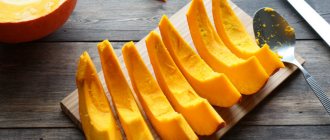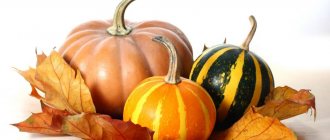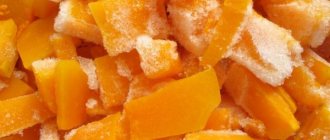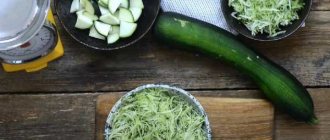Hello! In this article I will tell you how to quickly peel the hard skin of a pumpkin, remove the pulp from it and prepare pumpkin seeds. Pumpkin is a tasty and healthy fruit, but for many people peeling it is a real problem. Previously, every time I started cooking pumpkin, I experienced real stress before cutting it. But over time, I developed my own system and began to remove hard skin quite quickly and easily. I tried different methods from the Internet, and I’ll tell you about them too. And I give simple step-by-step instructions with photos: with it you can handle even the hardest-barked pumpkin in 7 steps. Forward!
Where do I start preparing all pumpkin dishes without exception? Yes, from her cutting. Precisely cutting, because I have never come across a fruit with a soft, tender, pliable crust. Regardless of the variety. Always a hard peel, and even wavy)).
Of course, the hardness differs depending on the variety, but over time I learned to cope with the hardest-barked specimens in 5-7 minutes. If it's not a giant.))
Different grades for cleaning
So, I stock up on a good mood. I have a fox with a bun on a stump; my child made it out of clay.)) And she is also red, I took her for support.
Features of cleaning depending on the type and variety of pumpkin
Today you can find a large number of varieties on sale, which may differ not only in shape and size, but also in the thickness of the peel. Conventionally, 3 types can be distinguished:
- Hard varieties - in this case, the peel can be compared in hardness to the bark of a tree, as a result of which cleaning will be quite difficult. A distinctive feature is the late ripening period and sugary taste.
- Large-fruited varieties - include a large number of species. Sometimes the pulp is compared to watermelon. The peel in this case is much softer than the previous version.
- Muscat varieties - the crop is harvested in an unripe state before the onset of the first frost. A distinctive feature is the fairly juicy and crispy flesh. Due to the fact that the peel is thin, the cleaning process does not take much time.
In addition, it is worth taking into account the fact that all existing varieties are divided into summer and winter. Thus, the fruits of summer varieties have thinner skins than winter ones, which are intended for long-term storage.
Important! In most cases, nutmeg pumpkin is consumed fresh.
How to peel a small pumpkin
Many housewives do not like to peel the pumpkin and this is not surprising, because this process takes not only a lot of time, but also effort. In addition, it is worth taking into account the fact that depending on the variety used, the thickness of the crust may differ, as a result of which you will have to put in a lot of effort to get the desired result.
As practice shows, most small fruits have a fairly soft rind, which, if necessary, can be removed with a vegetable peeler. In addition, the fruit can be placed in a microwave oven for some time, as a result of which you can not cut the vegetable into pieces, but cook it as a whole.
Housewives reviews
I have several muscat varieties. I peel potatoes and carrots with a vegetable peeler if I’m making candied fruits. And if you bake it, then with the skin.
Kukuzjaka
https://www.forumhouse.ru/threads/8616/page-14
I first cut the pumpkin into pieces, and then peel each part separately - it’s more convenient for me... Because I peeled the whole pumpkin a long time ago, it was also all wet from these efforts...
Galyana
https://kuking.net/my/viewtopic.php?p=1207651
This is how I clean it: I cut it in half and clean out the bones. Next, I place one half cut side down and cut it into very thick pieces lengthwise. Then I put each piece on its side and cut the skin with a knife (one piece will require several “cuts”). this way, when you peel off a thick skin, the knife is aimed at the board, and not at your fingers, and you can press with all your might.
Ella
https://kuking.net/my/viewtopic.php?p=1207651
Peeling a hard-barked pumpkin or old fruits with rough skin is quite difficult. To soften the skin, you can place the pumpkin in the oven or microwave for a few minutes.
Preparing pumpkin dishes most often requires first removing the peel. Vegetables with hard skins are not easy to peel, so to peel them, it is better to know some tricks.
Table: types and characteristics of pumpkin
| View | Variety of shapes | Peculiarities |
| Hardcore | Spherical, flattened on both sides - “buns”, as a rule, have a clear relief, and are ovoid. | Weight rarely exceeds 10 kg. They are distinguished by their hard, woody skin, which is difficult to cut with a knife. These pumpkins last longer, are used to create eco-friendly tableware, and are grown to produce nutritious seeds. Depending on the variety, they have a rich, sweet or bland, mild taste. The longer such a pumpkin is stored after harvesting, the harder the bark becomes. |
| Large-fruited | Mostly spherical and flattened with relief. | Some varieties reach a weight of 30 kg or more. The pulp is sweet and does not require long processing to soften. The peel is cut thinly and is easier to cut with a regular knife compared to hard-rind pumpkins. Does not become harder during storage. |
| Muscat | Pear-shaped (bottle-shaped). | They are distinguished by a characteristic nutmeg, nutty flavor and a high content of carotene in the pulp. The vegetable itself has a soft peel that can be easily cut with a knife. Difficulties in cleaning are most often associated with the unusual shape. The seeds are located in the center of the widest part of the pear-shaped pumpkin and are quickly cleaned out as they take up little space. |
To decorate personal plots and vegetable gardens, special hybrids are developed that are highly resistant to damage, take a long time to ripen, and have unusual shapes and colors. Interestingly, some ornamental varieties also have edible pulp. But chefs prefer not to use these types in preparing dishes, as they are very tough.
When preparing pumpkin dishes, I always choose nutmeg fruits. They are easy to process, the flesh is not hard, has a bright orange color and a sweet, pronounced taste.
Photo gallery: variety of pumpkins
Hard-barked pumpkin of the Dachnaya variety has oval-shaped fruits
The hard-barked pumpkin of the Acorn variety has a clear relief of segments and is popularly called acorn pumpkin
Large-fruited pumpkin of the Marble variety has juicy sweet pulp
The French pumpkin variety Muscat de Provence has a specific taste with a muscat tint and is often used for making pies and meat dishes.
Butternut squash of the Zhemchuzhina variety is characterized by good yield, cold resistance and drought resistance.
How to easily remove seeds and pulp
Pumpkin seeds are very healthy. They are used for several purposes:
- in folk medicine;
- as a tasty product rich in vitamins and minerals;
- for growing pumpkin;
- for decorating dishes.
It is recommended to remove pumpkin seeds immediately after cutting the vegetable. They can be collected by hand, washed and dried, spread on a flat surface in a thin layer.
After cutting the pumpkin, you must remove the pulp and seeds from it. It is convenient to remove the pulp with your hands or a tablespoon. If you want to maintain the shape of the pumpkin, you can cut off the lid and carefully remove the pulp and seeds using a long-handled spoon.
The pulp is not eaten. It deteriorates very quickly. If left, the cut fruit will begin to rot within a few days.
Seeds and pulp can be removed by cutting off only the top cap of the pumpkin.
Peeling
Let's move on to peeling the sun fruit from the hard crust. The less time the fruit has been lying, the thinner and softer its peel.
If pressing on the side of the vegetable leaves a slight dent, then there will be no problems with cleaning. If you feel that the peel is hard and tough, it means that the pumpkin has been lying around for quite a long time, but this does not mean that it has spoiled and cannot be eaten.
Thin-skinned pumpkin
Thin peel is easy to peel
If you are lucky and got a variety of fruit with a thin peel, then the half can be easily processed without cutting into pieces, using a vegetable peeler. For convenience, the half can be divided into slices and the crust can be cut off with short movements from top to bottom. Be sure to hold the fruit with your hand.
Hard-skinned pumpkin
If you come across a vegetable with a hard crust, no problem. There are several ways to peel hard skin from a pumpkin. The most popular methods are:
- using a microwave. Make shallow cuts in the rind of the selected clean and dried pumpkin. Place the vegetable in the microwave. For a better effect, it can be pre-wrapped in cling film or placed in a bag. If the fruit is large, it is better to cut it into pieces. At maximum power, you need to heat the vegetable for 2-3 minutes. You can then easily peel off the peel with a knife;
- in the oven. Line a baking sheet with foil or parchment, cut the vegetable if necessary, place cut side down and place in the oven. For a small fruit, 10 minutes at a temperature of 200 °C will be enough. If the vegetable is larger, then to soften the skin you need to hold it there for 15-20 minutes. The main thing is not to overcook, otherwise you will end up with a baked pumpkin dish. When the fruit has cooled, you can easily cut off the softened peel with a knife.
Another cleaning method
Another known way to soften the crust is to soak the product in water. It is necessary to take the culture and place it in water at room temperature for several hours. After such manipulations, you can easily remove the pumpkin peel. But there is an opinion that when soaked, the pulp loses its aroma.
If your product is purchased, there is a high probability that an ordinary vegetable peeler will be able to cope with it. If the tool is sharp and has a good handle, the process will not take you more than 5 minutes:
- cut the pumpkin and clean out the cavity;
- place half of the fruit to cut;
- remove the peel from top to bottom.
To avoid the hassle of peeling, first find out what type of pumpkin you have. By choosing the right option for removing vegetable skins, you will do everything efficiently and quickly.
Tips to make the process easier
The life experience of gardeners and pumpkin lovers has helped us find several ways that make it easier to remove the hard skin from the vegetable.
Soak
To facilitate the cleaning process, the fruit is soaked in cold water and left overnight. In the morning, they take it out and dry it with a towel. This method works well for nutmeg and large-fruited varieties with hard skin, but hard-skinned pumpkins cannot always be softened in this way.
Short heat treatment
It is better to soften the hard, woody peel by heating it. Pierce the prepared pumpkin with a fork, skewer or narrow knife on several sides. Place the product in the microwave and set the switch to maximum. After two minutes, remove and, while the pumpkin is still warm, cut off the skin. Pre-divide a large vegetable into parts.
Please note that for thin-skinned and juicy varieties, one minute is enough for the shell to become more pliable for removal.
You can also place the pumpkin in an oven preheated to 150°C for 15–20 minutes. Be careful not to overcook the fruit, otherwise the pulp will be baked and you will have to immediately use it for cooking.
Immediately after heat treatment, the peel from the pumpkin can be removed with a regular grater.
Using special devices
In addition to a vegetable peeler, the peel from a raw fruit is removed by a special knife consisting of many ring-shaped blades. Lightly pressing on it, you need to go over the entire fruit from the tail to the bottom. This device is suitable for processing small vegetables with a thin shell, as well as hard-bodied, unripe pumpkins recently removed from the garden.
Video: using a knife to peel a pumpkin using an orange as an example
How to prepare pumpkin for freezing
A properly cut pumpkin does not take up much space in the freezer. For quick freezing, only ripe fruits that are not affected by rot are selected. The pulp is prepared in the following ways:
- prepare puree;
- cut into small cubes;
- grind on a grater.
The first option for preparing vegetables allows you to use the pulp right away. Other methods require preliminary heat treatment, because the pulp is kept fresh. By using the appropriate freezing method, you can prepare healthy dishes from the juicy pulp all winter. The shelf life of frozen vegetables is limited, so the date of preparation should be indicated on the packaging.
How to make pumpkin puree correctly
The shelf life of pumpkin puree in the freezer is no more than 10 months. It can be immediately added to casseroles, pies, cereals and other dishes. The semi-finished product is prepared as follows:
- The melon is cut in half and freed from seeds.
- To make puree, the pulp is first prepared in one of the following ways: boiled, baked, steamed or microwaved. The peel does not need to be removed.
- To obtain puree you will need a blender, fork or masher. The pulp is scooped out with a spoon, then kneaded until a homogeneous mass is obtained.
- The puree is distributed into containers: containers, special forms, plastic glasses. The filled container is placed in the freezer.
Important!
If the finished puree is stored in a container with a lid, it should be taken into account that when frozen, the mass will increase in volume. Therefore, there is no need to fill the container to the very edge.
Freezing fresh pumpkin
Melon can be frozen raw so that you can later prepare various dishes from it. This semi-finished product makes delicious pancakes, pies, porridges and side dishes. The preparation is made in this way:
- The pulp is cut into pieces or grated.
- The finished product is dried with a towel, placed on a tray and sent to the freezer.
- After 2-3 hours, the frozen pulp is put into bags, then returned for long-term storage.
Plastic bags or food containers are suitable as containers. When filling the container, leave 1.5 cm of free space from the top. Before sealing the bag, you should try to get as much air out of it as possible. It is advisable to make small portions of grated vegetables - up to 500 g in each package. Raw frozen food can be stored for up to 12 months. Butternut squash can be used without first thawing. The firm pulp is added to hot sauce or soup.
Many varieties of pumpkin grow very large. Therefore, it is difficult to eat a vegetable at one time, even if there are fans of such dishes in the family. Fruits often deteriorate when kept in a damp basement for a long time. The easiest way to preserve a delicious vegetable is to freeze it. The right approach allows you to obtain a useful product that is ready for quick use. Pumpkin dishes can be prepared throughout the year.
Steamed pumpkin - general cooking principles
Cooking steamed pumpkin is very simple. You need to separate the desired piece from the vegetable, wash it, and dry it. Cut the pumpkin into strips, cubes or random pieces. The skin can be cut off or left (it comes off very easily from steamed pumpkin).
Any utensil is suitable for preparing the dish. It can be a regular saucepan, oven, double boiler, multicooker. The point is that the vegetable pieces are exposed to hot water steam, and how to do this is up to the housewife herself.
Pumpkin cooks very quickly. Literally in half an hour, no matter what cooking method the hostess chooses, the slices will be ready.
Preparing for cleaning
The dense skin of a pumpkin is difficult to cut, so it is important to choose a sharp knife with a comfortable handle and a blade 10–15 cm long. Hard-barked varieties lend themselves better to a serrated cutter. For thin-skinned varieties, you will need a metal spoon and a vegetable peeler.
Small fruits
Small fruits, the diameter of which does not exceed 10–15 cm, are washed under the tap in the kitchen sink or in a basin of water. After cleaning them from dirt and dust, dry them using thick paper napkins or a clean cotton towel. For specimens that fit in the palm of your hand, this is enough to move on to the next stage.
If the pumpkin cannot be held with one hand or it has an awkward shape, first cut it into two halves. Divide vegetables that have a pronounced relief into existing segments, this will make it easier to clean.
It is most convenient to cut a segmented pumpkin into crescents, and then peel each piece individually
Large fruits
Pumpkins that exceed 20–50 cm in girth or more are more convenient to wash in the bathroom using a shower. After this, they are also dried with a towel.
If there is not enough space in the kitchen, then carry out the first stage right in the bathroom, dividing the fruit into two halves. To do this, insert a wide knife into one of the poles of the vegetable and turn it so that its flesh begins to crack, but do not break the pumpkin. Once you have a small hole, cut the fruit lengthwise around the entire circumference, gradually turning it over. If after this the parts are too large, divide them into quarters and work with them one at a time.
Large pumpkins are more difficult to process due to their weight and scale, so for convenience, immediately prepare a place sufficient for comfortable movement and placement of parts of the fruit. To quickly free up space around, place freezer bags and cling film in an accessible place. Then the unclaimed pieces can be immediately removed for storage.
Further use
After heat treatment, the pieces remaining after cooking the dish are stored well in the refrigerator, but no more than a week:
- The vegetable is cut into cubes, placed in portions in plastic bags, and placed in the freezer. When frozen, the shelf life increases to a year. The taste of such pumpkin is practically no different from fresh one.
- To make cooking easier, the leftovers are pureed and stored in the freezer. As needed, the product is taken out and added to porridges, soups and other dishes.
- If you plan to use the vegetable as a basis for fresh juice, squeeze a small amount of lemon juice onto the pulp. Moreover, the beneficial properties of such a product last only 2-3 days at a temperature of 0…+4°C.
Pumpkin dessert will be tastier if you add a little honey instead of sugar. The pleasant aroma and taste will go well with the soft and juicy pulp.
Storage rules
Pumpkins of almost all varieties are stored until spring in the basement at a temperature of +12...+15°C. They are placed on racks and a bed of straw.
In a city apartment there are 2 storage options: on a glazed balcony or loggia and simply on the floor. In the first case, the pumpkin is suitable for consumption for 5-6 months at a temperature not lower than +2°C and air humidity not higher than 75–80%. In this case, the following conditions are met:
- the fruits are covered with breathable, opaque material to prevent sunlight from entering;
- pumpkins are not placed on a cement floor, linoleum, plastic (boards, plywood, thick fabric are more suitable);
- with the onset of severe frosts, vegetables are wrapped in a blanket or other insulation.
When stored on the floor, vegetables are isolated from each other and protected from sunlight. This way they will not lose their quality until almost summer, if the skin has not been damaged.
Keep the peeled pumpkin in the refrigerator for no more than two weeks, after greasing the cuts with sunflower oil and wrapping the vegetable in cling film. The product can be stored in the freezer for up to 12 months.
Table: types and characteristics of pumpkin
In order to peel the peel using a kitchen knife, it is recommended to adhere to the following work algorithm:
Expert opinion
Ekaterina Korneva, expert in the field of care, cleanliness and beauty
I will help you understand all the intricacies.
Each part must be placed cut side down on a cutting board, then remove the peel with a knife, making planing movements. Large pumpkins are more difficult to process due to their weight and scale, so for convenience, immediately prepare a place sufficient for comfortable movement and placement of parts of the fruit. Method No. 1 If you have any questions, please contact me, I will be happy to answer!
To clean or not to clean
For housewives wondering whether it is necessary to peel vegetables, there is good news: it is not necessary. It all depends on the dish you are going to prepare from it. And you can prepare many such dishes, from the well-known millet porridge, to filling for pies, salads and meat dishes.
The skin of baked pumpkin peels off easily after cooking.
You can simply bake the pumpkin in the oven, sprinkle it with sugar or water it with maple syrup, you can stew it in the oven on a baking sheet, adding a little water, you can grate it - in all these cases there is no need to remove the skin at all. When baked or stewed, it will easily come off after cooking; just throw away any remaining grated crust. There are recipes when dishes are prepared in a whole pumpkin; here there is no question of cleaning.
Mandatory procedure
Every person uses one or another vegetable dish in their diet almost every day. True, this does not happen as often with pumpkin as, for example, with potatoes. Although it should be noted that this product has much more benefits. Its use helps improve vision and normalize digestion, extinguish inflammatory processes and strengthen the immune system. Therefore, you should not leave your body without such a strong helper. Moreover, pumpkin dishes are not only healthy, but also very tasty. It is used to prepare various soups, porridges and casseroles. This vegetable is used to make wonderful stews and pancakes, bake cookies and pies, and brew aromatic tea. Any of the recipes listed is worth a look, but they all start with the same procedure. You need to know how to peel a pumpkin.
Of course, first, like any product, you need to wash it thoroughly. After all, such a beauty grows in the garden and has direct contact with the ground. Therefore, the first step is to rinse the surface under running water. Further actions depend on the specifics of the specific recipe. But in most cases, housewives have to decide how to clean the pumpkin.
The easiest way is to cut it lengthwise and then methodically cut off the thick skin with a sharp knife. But this is not always the case.
What you need to carve a hard pumpkin
Pumpkin varieties suitable for long-term storage are distinguished by their rough skin. Sometimes it is as hard as a nut shell. During long-term storage, the peel hardens even more. Cleaning such a vegetable is very difficult and requires significant physical effort. Large-fruited varieties are especially difficult to cut. To cut hard-barked melon, you will need the following kitchen tool:
- cutting board;
- small knife;
- vegetable peeler;
- metal spoon or scraper;
- massive knife.
Cutting board and large knife
Using a cleaver knife, you can cut the melon in half in one fell swoop. It is convenient to remove the fibers with seeds with a metal spoon or scraper. To make it easier to cut the vegetable into pieces, you first need to divide the halves into small chunks. They are cut lengthwise or crosswise using a heavy knife. You should act with extreme caution, because... It is easy to get hurt with a sharp bladed weapon.
Important!
Before cutting the melon vegetable, you should make sure that its position is completely stable.
Pumpkin is cut on a cutting board. It is chosen according to the size of the vegetable. It won't fit on a board that is too small. The fruit should lie completely on a flat surface. For cutting, take a fairly large, thick and heavy board. In this case, the furniture will be reliably protected even if the knife comes off. Do not try to cut the fruit with one hand, holding it at an angle or hanging.
Contraindications
- the fruit is cut into halves. To do this, use a saw knife;
- To remove the peel, use a vegetable peeler or a knife with a straight blade without teeth. The blades must be sharp;
- to make it easier to process vegetables, they can be cut into small pieces so that they can be comfortably held in your hand;
- Cleaning begins from the edge, this makes it easier to remove the shell.
For housewives, peeling a pumpkin is a whole ordeal. This process is most annoying in winter; by this time the peel becomes even harder, so considerable effort is required to avoid injury during processing. It is necessary to peel the pumpkin so that the dishes are tender and tasty.
Simple cleaning methods
Professional chefs from around the world have come up with several simple ways to properly clean a pumpkin. All of them are quite easy and do not require special skills or time from you. Not only an experienced housewife, but also a beginner can easily cope with such work.
Traditional method
This method of cutting a pumpkin is the simplest and most frequently used. It allows you to quickly and easily separate the skin from the pulp with minimal losses. Each stage of the work must be performed very carefully so as not to cut yourself with a sharp knife. If everything is done correctly, then in just a few minutes you can get pulp ready for further preparation. To complete this job you will need a wooden cutting board, a large sharp knife and a tablespoon.
The process of peeling and removing pumpkin seeds using the traditional method is very simple and consists of the following steps:
- First of all, the vegetable must be thoroughly washed with cold tap water.
- Then wipe with a piece of cloth or dry with paper towels. This operation will help make the vegetable not so slippery and simplify the whole process.
- The prepared pumpkin is placed on a cutting board with the tail facing up.
- Then it is cut into two parts using a sharp and wide knife.
- Using a tablespoon, remove all the seeds and the fibrous part of the fruit from the two halves.
- The removed mass is transferred to a bowl. The seeds are removed from it, washed with water and dried in the sun. After this, they are eaten as a separate product.
- Each pumpkin halves is cut into several wide slices. This is necessary so that it is convenient to hold pieces of fruit in your hands and peel them.
- Using a well-sharpened knife or vegetable peeler, remove a thin layer of peel from each slice. This is done with short and sharp movements from top to bottom.
- Then the remaining unedible fibers are removed with a spoon.
- If necessary, the pumpkin is cut into smaller pieces and cooked. In addition, you can wrap the vegetable in cling film and put it in the refrigerator. In this state it can be stored for quite a long time.
Microwave
If you bought a pumpkin a long time ago and it stayed with you for more than a week, then its skin has become even rougher and more difficult to remove. In this case, various modern devices, such as a microwave, come to the rescue. With its help, you can slightly soften the top layer of the fruit and simplify the process of cutting it. To do the job you will need a wide knife with a well-sharpened blade, a large cutting board, a microwave and a tablespoon.
Housewives reviews
I have several muscat varieties. I peel potatoes and carrots with a vegetable peeler if I’m making candied fruits. And if you bake it, then with the skin.
Kukuzjaka
https://www.forumhouse.ru/threads/8616/page-14
I first cut the pumpkin into pieces, and then peel each part separately - it’s more convenient for me... Because I peeled the whole pumpkin a long time ago, it was also all wet from these efforts...
Galyana
https://kuking.net/my/viewtopic.php?p=1207651
This is how I clean it: I cut it in half and clean out the bones. Next, I place one half cut side down and cut it into very thick pieces lengthwise. Then I put each piece on its side and cut the skin with a knife (one piece will require several “cuts”). this way, when you peel off a thick skin, the knife is aimed at the board, and not at your fingers, and you can press with all your might.
Ella
https://kuking.net/my/viewtopic.php?p=1207651
Peeling a hard-barked pumpkin or old fruits with rough skin is quite difficult. To soften the skin, you can place the pumpkin in the oven or microwave for a few minutes.
Peeling a pumpkin takes 3-10 minutes. Processing time depends on the variety of fruit, the softness of the peel, the size and shape of the vegetable. If you are doing this for the first time, the process may seem laborious, as it requires a certain dexterity and physical strength. Simple tips for beginners will help you cope with this task.
Rules for storing pulp
Properly storing a pumpkin is no less important than properly cleaning it. The taste of the vegetable and the dish in which it is used will depend on this. There are many storage methods, but you should focus on the following:
- If you do not use the whole pumpkin, but only half of it, then the remaining part does not need to be cleaned of seeds, hard fibers and peel. This way the vegetable will be better preserved and will not lose its beneficial properties. In this form, pumpkin can be stored for no more than 5 days. After this, the pulp will begin to become sluggish and lose its taste.
- If necessary, you can store peeled and chopped vegetables. To do this, put all the pieces in a plastic bag and put them in the refrigerator. For larger pieces it is better to use cling film. The product can be stored in this form for no more than 3 days. As a rule, the edges of the vegetable will wilt, so they must be carefully cut off before further use.
- You can also store peeled pumpkin in the freezer. There she is able to lie much longer and not lose her vitamins and microelements. Before placing in the freezer, wrap the pumpkin in a plastic bag or wrap it in cling film.
Peeling a pumpkin is a rather labor-intensive process, and without knowing some secrets it can turn into real torture. To prevent this from happening, you need to take into account all the advice of professionals - they will allow you to easily peel the vegetable and prepare a delicious dish from it that will appeal to all members of your family.
Drying pumpkin seeds in the oven
You can dry pumpkin seeds in the oven as follows:
- First you need to bring the temperature in the oven to 60-80 degrees.
- Then grease a wide baking sheet with vegetable oil and place the seeds, dried after washing, on it.
- The baking tray must be placed strictly in the middle of the oven.
- Drying the seeds in the oven will take approximately 20-30 minutes. During this time they need to be stirred periodically.
After cooking, it is better to taste the seeds: they should not be wet or crunchy on the teeth.
After this procedure, pumpkin seeds can be stored for quite a long time. It is recommended to put them in a cloth bag and keep them in a dry and dark place.
Thanks to the vitamins A, C, E, group B, PP contained in pumpkin, microelements (potassium, magnesium and others), fiber, pectin, it rightfully occupies a leading place in terms of usefulness in human nutrition. It is suitable for children, including infants, the elderly, and pregnant women. The unique composition of the pulp makes the vegetable useful for preventing the development of cardiovascular diseases; it has a diuretic, antiemetic effect, and helps fight toxicosis of pregnant women and insomnia. The vegetable helps with anemia and exhaustion of the body, liver diseases and many other diseases. Its seeds are no less useful. Regardless of the part, the pumpkin should be properly cleaned before consumption.











